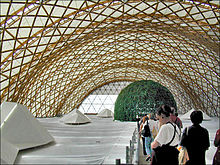Shigeru Ban
From Wikipedia, the free encyclopedia
| Born | August 5, 1957 Tokyo, Japan |
|---|---|
| Nationality | Japanese |
| Awards | Pritzker Prize (2014) |
| Buildings | Centre Pompidou-Metz, France Cardboard Cathedral, Christchurch, New Zealand |

Takatori Catholic Church is a temporary church building erected in Kobe after the Great Hanshin earthquake in 1995. It was donated (deconstructed and moved) to Taiwan in 2005.

Ban designed the Nomadic Museum with engineer Buro Happold, a temporary structure composed of 156 shipping containers (2006)
In 2014, Ban was named the 37th recipient of the Pritzker Architecture Prize, the most prestigious prize in modernist architecture.[3] The Pritzker Jury cited Ban for his innovative use of material and his dedication to humanitarian efforts around the world, calling him "a committed teacher who is not only a role model for younger generation, but also an inspiration."[3]
Early life and education[edit]
Ban was born in Tokyo, Japan. He studied at the Tokyo University of the Arts,[1] and then at the Southern California Institute of Architecture. Later he went to Cooper Union's School of Architecture, where he studied under John Hejduk and graduated in 1984.[1] Hejduk was a part of the New York Five. From Hejduk, Ban not only learned fundamental elements of architecture, but also gained an interest in "architectonic poetics" or the creation of "three-dimensional poetry". Hejduk, the most experimentally minded of the New York Five,[citation needed] had a lasting influence on Ban, whose work reflects continuing explorations into basic geometric elements.[citation needed] Ban's formal explorations with basic building materials helped to lead him into unique structural solutions.Design approach[edit]
For Ban, one of the most important themes in his work is the "invisible structure". That is, he does not overtly express his structural elements, but rather chooses to incorporate them into the design. Ban is not interested in the newest materials and techniques, but rather the expression of the concept behind his building.[citation needed] He deliberately chooses materials to further this expression.Ban's work encompasses several schools of architecture. First he is a Japanese architect, and uses many themes and methods found in traditional Japanese architecture (such as shōji) and the idea of a "universal floor" to allow continuity between all rooms in a house. In his buildings, this translates to a floor without change in elevation. By choosing to study under Hejduk, Ban opted to do something different. Hejduk’s rationalist views on architecture provided a way of revisiting Western modernism and gaining a richer appreciation than the reductive vision of it as a rationalized version of the traditionalist—yet ultra-modern—Japanese space. With his Western education and influences, Ban has become one of the forerunning Japanese architects who embrace the combination of Western and Eastern building forms and methods. Perhaps most influential from Hejduk was the study of the structure of architectural systems. Ban is most famous now for his innovative work with paper and cardboard tubing as a material for building construction. He was the first architect in Japan to construct a building primarily out of paper with his paper house, and required special approval for his building to pass Japan’s building code. Ban is attracted to using paper because it is low cost, recyclable, low-tech and replaceable. The last aspect of Ban’s influences is his humanitarianism and his attraction to ecological architecture. Ban's work with paper and other materials is heavily based on its sustainability and because it produces very little waste. As a result of this, Ban's DIY refugee shelters (used in Japan after the Kobe earthquake, in Turkey, Rwanda and around the world) are very popular and effective for low-cost disaster relief-housing.
Ban created the Japanese pavilion building at Expo 2000 in Hanover in collaboration with the architect Frei Otto and structural engineers Buro Happold. The 72-metre-long gridshell structure was made with paper tubes. But due to stringent building laws in Germany, the roof had to be reinforced with a substructure. After the exhibition the structure was recycled and returned to paper pulp.[2]
Ban fits well into the category of "Ecological Architects" but he also can make solid claims for being modernist, a Japanese experimentalist, as well as a rationalist. Natias Neutert, German thinker, critic, and poet, marks Ban in his essay as "a gentle revolutionary ... guiding contemporary architecture towards transparency, the spherical and the open."[4] Ban himself quotes: "I don't like waste," summing up his philosophy and practice, known as "Paper Architecture".
...


